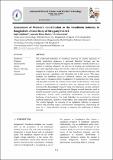| dc.description.abstract | The traditional technique of Handloom weaving, an ancient approach to
textile production, possesses a profound historical heritage and has
undergone notable evolutions throughout its existence. Initially utilized as a
method of offering safeguard, the practice of weaving has transformed and
now holds significant importance in the realms of fashion and performance.
Sirajganj is recognized as a prominent center for the handloom industry, with
women playing a significant and influential role in this sector. This paper
explores the handloom industry's historical, cultural, and socioeconomic
importance in Sirajganj District, Bangladesh. It emphasizes the roles, issues,
and potential solutions for women's involvement in this industry. This study
utilizes a combination of secondary data and primary field surveys to
scrutinize the demographic characteristics, working hours, income, and level
of empowerment among female weavers. Despite several obstacles, such as
limited financial resources, potential health hazards, sexual harassment, and
exploitation, women make substantial contributions to the economic
landscape of the business. The study highlights the necessity for enhanced
working conditions, equitable remuneration, and competency enhancement.
The results highlight the capacity of the handloom industry to empower
women and positively impact socioeconomic development, emphasizing the
need for a comprehensive strategy to improve the well-being of female
weavers. | en_US |

